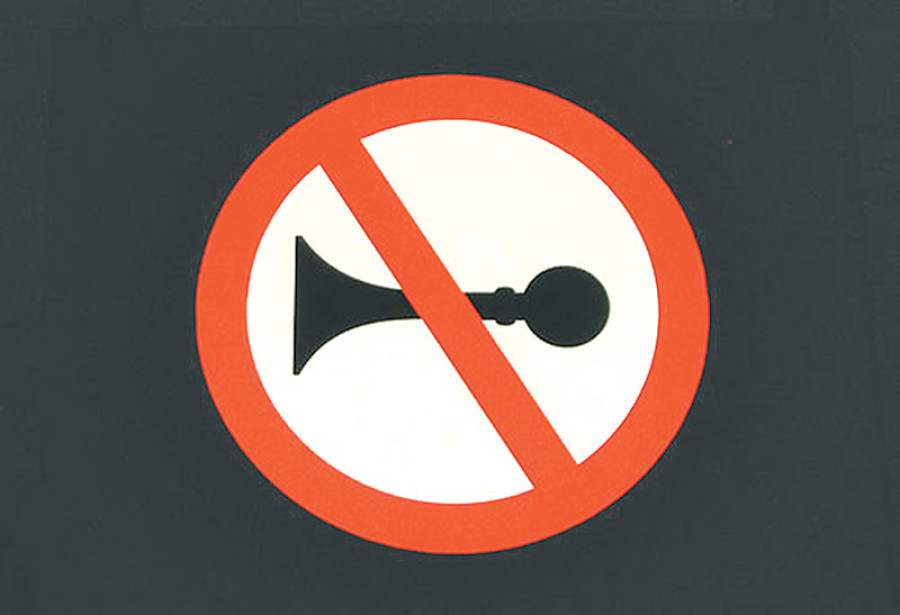Opinion
No horn, please
The Traffic Control Department of Nepal Police has recently implemented a plan penalising the blowing of vehicular horns in inappropriate places. This was a long overdue and welcome step. But there are various flaws in this plan—especially in its execution.
Khagendra N. Sharma
The Traffic Control Department of Nepal Police has recently implemented a plan penalising the blowing of vehicular horns in inappropriate places. This was a long overdue and welcome step. But there are various flaws in this plan—especially in its execution.
There are various aspects to consider when it comes to the Nepali habit of blowing horns. The first aspect is that it causes noise pollution. So many vehicles blow horns unnecessarily, creating a deafening effect. It is irritating to say the least.
The second aspect of the problem is attitudinal. In our society, a cyclist considers himself above the pedestrian, the motor cyclist considers himself above the cyclist, four wheel drivers consider themselves superior to the two wheelers. And there are various classes of the four wheel owners. At the lowest level is the taxi driver, followed by private owners, and then by government-owned vehicles.
Hierarchical society
Nepali society is hierarchical in various senses and the most conspicuous hierarchy is the grades of the vehicles running on the roads. You can easily discern the classes through the colour of the number plates hanging on the vehicles. For example, white denotes government ownership, red denotes private ownership, black denotes a taxi, yellow represents corporate ownership, red and blue denotes a diplomatic class, green denotes tourist vehicles and so on. All these vehicles fight for supremacy on the roads and they take the horn to be the best solution to the confusion.
The third part of the problem is the traffic police. The primary purpose of the traffic police is to guide the drivers in line with given laws and procedures. Often times, however, the traffic police are seen breaking the laws through discriminatory behaviour and complacency.
Another issue with the traffic police is that there is no police patrol that randomly checks for wrong driving practices. The traffic police are seen only in various cross sections of the city roads, which makes it easy for traffic offenders to sneak by. Apart from blowing horns in inappropriate places, there are various other traffic offences, such as no use of the turn signal on street corners, high speeds on the city streets, and so on. Most teenage motor cyclists have removed their silencer pipes and drive their bikes at breakneck speeds, creating a highly irritating sound and terrorising the people on the street. The traffic police have adopted a complacent attitude to this behaviour.
Control measures
Let’s talk about solutions. In the past, noise pollution was not considered a social problem. Long ago there was a sign outside the Bir Hospital requesting drivers not to blow horns around the hospital. However, I cannot recollect any instances where compliance or defiance of that code was monitored. Now, such signs are hardly found around the many hospitals established in the Kathmandu Valley. In the more recent past, the Nepali Traffic Police have been able to check drunken driving by conducting random checking. That action was a phenomenal success in Nepal. It has been admired in foreign circles, too.
The recent no horn plan was a popular topic in the media in its early phase. The traffic police also appeared quite excited in the beginning. Though I have no formal knowledge of its official monitoring, I have seen interest waning. This rule may have been observed to some degree in the cross sections because of the presence of police, but there is no change in the behaviour of the drivers in other areas where there are no police personnel. So it has achieved partial success.
Social issue
Blowing horns is not only a traffic issue; it is part of a larger social issue. People are all affected by the loud sounds coming from the roads and the speed with which the drivers drive. This has multiple adverse effects. There should be a good monitoring system for abnormal driver behaviour, with provisions of due punishment. There should be speed limits in citiy centres, near schools, and in other places with crowds.
Then, there is the case of pedestrian street crossings. The recent failure to impose zebra crossings is a lesson. There are very few zebra crossing spots with faded signs. They should be marked properly at regular intervals so as to make it easy for pedestrians. There are dangerous cross sections with more than four outlets and there are no flyovers in many such points. Flyovers must be built as soon as possible in such cross sections. Meanwhile, police presence should be increased during rush hours.
Finally, sound pollution is not only a traffic problem, it is also a health problem. The Department of Health Services and the traffic police should work to draft an anti-noise pollution policy. Noise pollution should be defined in technically measurable quantities and all noises above the permissible levels should be made punishable. Nowadays, there is a growing tendency of organising public religious events like Maha Puran, non-stop prayers and the like where loud speakers are deafening. Such functions should also come under the category of noise pollution and must be controlled. Or else the number of people with deafness will increase.
- Sharma is a political analyst




 10.12°C Kathmandu
10.12°C Kathmandu











